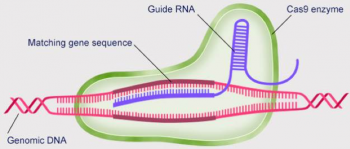Serendip is an independent site partnering with faculty at multiple colleges and universities around the world. Happy exploring!
Gene Editing with CRISPR-Cas – A Potential Cure for Severe Sickle Cell Anemia

This analysis and discussion activity introduces Victoria Gray whose severe sickle cell anemia was effectively treated by gene editing with CRISPR-Cas.
To begin, students review the molecular biology of sickle cell anemia, transcription and translation.
Next, they learn how bacteria use CRISPR-Cas to defend against viral infections. Then, students examine some of the research findings that scientists used to identify the target for gene editing.
Finally, students analyze the CRISPR-Cas gene editing treatment for sickle cell anemia.
The Teacher Notes present an optional additional video and question to stimulate students to consider the ethical controversies related to potential uses of CRISPR-Cas.
The Student Handout is available in the first two attached files and as a Google doc designed for use in online instruction and distance learning. The Teacher Notes, available in the last two attached files, provide instructional suggestions and background information and explain how this activity is aligned with the Next Generation Science Standards.
| Attachment | Size |
|---|---|
| CRISPR sickle cell SH.docx | 2.94 MB |
| CRISPR sickle cell SH.pdf | 857.9 KB |
| CRISPR sickle cell TN.docx | 1.09 MB |
| CRISPR sickle cell TN.pdf | 658.9 KB |











Comments
2024 revision
I have updated the Student Handout and Teacher Notes with recent research and the recent FDA approval of the gene-editing treatment for sickle cell anemia. For the Student Handout, I have revised several questions to focus on the most important points and added a page of questions to review transcription and translation, which will help students understand how the gene-editing treatment works. I have also clarified and updated the Teacher Notes, and I have suggested a video that could be used to increase student interest and motivation.
Ingrid
2022 revision
The Student Handout has been revised to focus more on basic biology. I have moved the discussion of the ethics of CRISPR-Cas to an optional section proposed in the Teacher Notes. I have added information to the Teacher Notes. In addition, the Teacher Notes have been reorganized for better logical flow.
Ingrid
Disability Studies perspective
For a disability studies perspective on the use of CRISPR, see:
https://serendipstudio.org/oneworld/critical-disability-studies-theory-and-practice-2018/modern-eugenics-disability-theory-perspective
"During the eugenics movement, the concept of the perfect citizen began to take form as technology had given society the ability to prevent certain individuals from reproducing. As this idea took shape, the disability community was negatively impacted, since society held a belief similar to that of Peter Singer’s such that an individual with disability was not a “person” (Gabbard). While gene-editing technology continues to advance, issues raised during the eugenics movement have begun to resurface as we ask ourselves which conditions we should aim to eradicate. CRISPR-Cas9 gene editing is one such technology that has the potential to help erase lethal diseases from the population, but also has the potential to erroneously attempt to eradicate forms of human diversity such as disabilities (Hayden)."
Post new comment